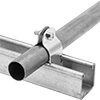Filter by
Rail Height
Material
Color
T-Slotted Framing Component
Single Rail Profile Style
Bracket Type
Rail Width
Shape
Locking-Slotted Framing Component
Thread Size
Finish
Bolt-Together Framing Component
T-Slotted Framing Nut Type
Corner Bracket Style
DFARS Specialty Metals
Building and Machinery Hardware
Raw Materials
Material Handling

Conveyor Chain Trolleys
Carry loads smoothly along overhead enclosed-track powered conveyors
1 product
Communication
Measuring and Inspecting
Containers, Storage, and Furniture
Heating, Ventilation, and Air Conditioning
Safety Equipment
Electrical
Fastening and Joining
Fabricating and Machining
Facility and Grounds Maintenance


































































































































































































